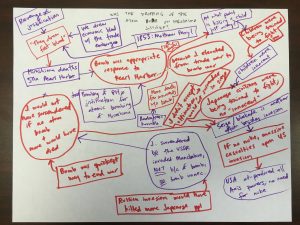Here are some problems that have cropped up in my pop-up debates this year:
- Students give their mandatory speech and then sit down and disengage from the ongoing discussion — so, poor listening;
- Students repeat one another — which is both a cause and an effect of poor listening;
- Students make effective arguments that are then left unaddressed by the rest of the speakers in the debate — so, poor argumentation.
Problems like these have a single, simple solution: mandatory tracking of the argument. When our students (and us at first on the board or the doc cam) write down each student's contribution to a pop-up debate using a simple set of rules, we increase the quality of their listening and the quality of their resulting argumentation.
Before I show you how we do this, I need to credit Les Lynn of Argument-Centered Education for teaching me the great utility of argument tracking (or “flowing” as the pro debaters call it).
How to track an argument
I've tried doing this many ways, but at the earliest stages I like the approach Les Lynn shares in his accessible “Superhero Square-Off” activity best. Here is what it looks like:
And here is what's going on in those figures (which you can click to enlarge):
- Our debate question, at the top of the page, was “Was the USA justified to use atomic force on Hiroshima?”
- This was our second time debating the question; the first time produced enough poor fruit to make we want to revisit the question and add the tracking requirement.
- Each side is assigned a color.
- Each argument is circled.
- Each counter-argument is boxed and linked to the argument it responds to with an arrow.
- Each refutation (an attempt at defeating a counter-argument) is also boxed and linked with an arrow to the counter-argument it responds to.
- Only new, “additive” argumentation is tracked. If a student pops up and contributes something that repeats a prior argument or goes on an unproductive tangent, their arguments are not recorded.
As I'm doing this on the document camera during the debate, I'm frequently asking arguers to restate or clarify. This signals to arguers that they have a responsibility to be clear, and this tends to perk the ears of the listeners who are tracking the argument. They shift from passive recipients of pop-up debate speeches into active evaluators.
At times I “call” an argument — for example, I say that the blue team has effectively defended their counter-argument against the red team's “Japan received an ultimatum and did not respond, and, therefore, the Hiroshima bombing was justified,” and, therefore, the red team loses their argument. Or if I'm not sure who has won an argument (after all, I typically don't adjudicate pop-up debates, so I don't have a ton of practice), I'll say something like, “Okay, let's call that line of argument a draw — who has a new argument?”
The “pop-up” format exists as a “simple to a fault” structure for facilitating and managing whole-class discussions, conversations, arguments, or even toasts. When we're putting together pop-up debates, our mentality has to be that of the improvementist versus the perfectionist. I hope that Les Lynn's visual tracking method can be a useful way for you and your students to improve.


Sherri says
Love this idea…we are planning on a bit more formalized…not really…but not pop up…debate: last human right standing…using a tournament bracket and student voting till we get the most important/influential human right “standing”…I love this as a way for students to keep track of the arguemtnys for and against…ties into a small unit we did I on visual notes…thanks for the idea! As always lov e your stuff!
davestuartjr says
Sherri, I hope this went well! Your idea has lodged itself in my mind and I may just try this out at the end of the year!